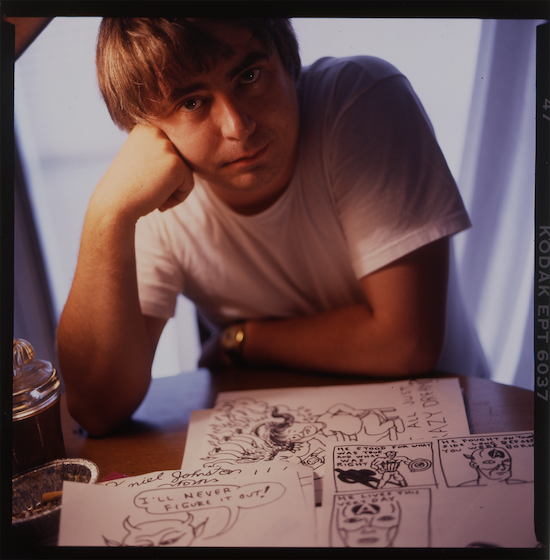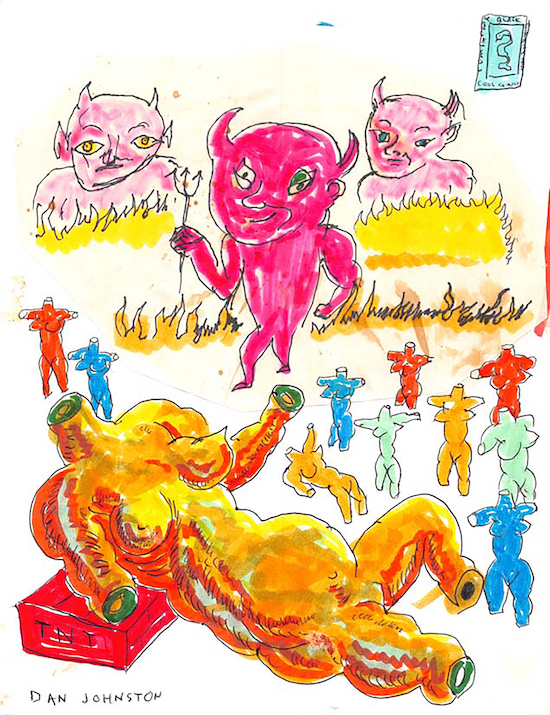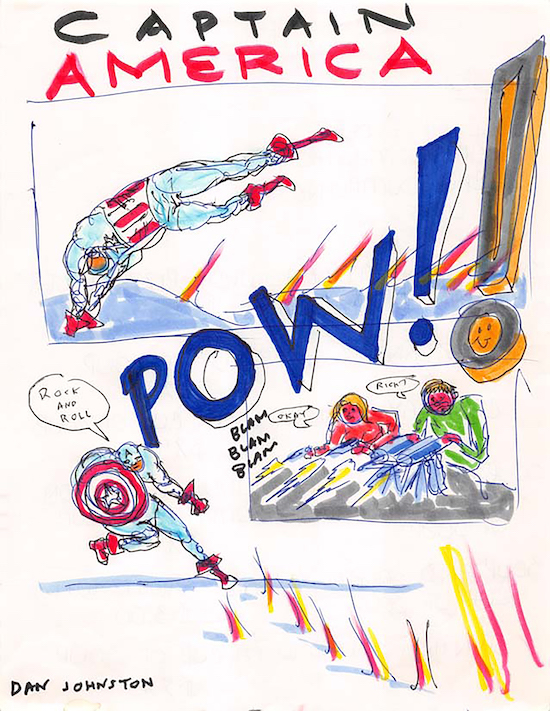POW, 1978. Ink and marker on paper. 11 x 8.5 in
Daniel Johnston, the legendary outsider artist beloved by Beck, Wilco, and Kurt Cobain, is the subject of a new exhibition, Psychedelic Drawings, at New York’s Electric Lady Studios. While best known as a singer-songwriter, Johnston – who died in September 2019 of natural causes, after a forty year struggle with severe mental illness – always identified as an ‘artist’ across the board, with a reverence for comic books, cartoons, and drawing that predated his taste for music.
Running till 7th February and available to view online, Psychedelic Drawings is the headline of this year’s Outsider Art Fair, an annual event that celebrates artists from unconventional and neurodiverse backgrounds.
“The psychedelic experience is partially defined as ‘an apparent expansion of consciousness,’” says Lee Foster, the manager of New York’s Electric Lady Studios. “Daniel went places that most of us clearly never go to.”
“What I think is most fascinating about him is that he so compulsively documented what he saw – like an explorer drafting the first maps of an uncharted space.”
Gary Panter, an artist and the exhibit’s curator, describes Johnston as a “self-taught visionary artist”. Exhibited in galleries around the world, visual art was critical to Johnston’s appeal even from his earliest cassettes. Notably, the delicate, marker-drawn cover of Hi, How Are You?, when worn on a t-shirt by Kurt Cobain at the MTV Music Awards in 1992, is credited with first catapulting Johnston into popular awareness.
“I think Daniel was subject to an imagination turned up to eleven”, says Panter, who selected thirty drawings for the exhibit. “He saw the things he drew in some way similar to his drawings, but subject to the limits of drawing. It is hard for drawing to really match imagination.”

Portrait of Daniel Johnston. Courtesy of The Daniel Johnston Trust
Johnston’s sketches, like his songs, are messy, untrained, DIY: constructions of felt-tip markers and bright, primary colours, which often cross outside the lines. Fans of Johnston will notice, too, the appearance of characters like Captain America, The Hulk, Frankenstein, and Casper The Friendly Ghost, who show a remarkable constancy in the artist’s work.
In this exhibit alone, Captain America features in pieces from as early as 1978 and well up to the 2000s, in a style that’s remained broadly similar. “I forgot to grow up, I guess”, Johnston told Rolling Stone. “I’m a simple kind of guy, just like a child, drawing pictures and making up songs, playing around all the time.”
For Johnston, however, these characters are more than nostalgic nods. In his visionary schema – much like William Blake’s self-created mythology of fairies, holy spirits, and goddesses – the characters hold a deeply symbolic status, resonating on fundamental questions and grand tensions. In works like ‘I Dream of Good Versus Evil’ and ‘Faith Is Belief’, Captain America personifies good and wisdom itself, holding the airs of a mystic with short Zen-like snippets.
Equally, Casper The Friendly Ghost seems to stand in for God (or Satan, it’s not clear) in ‘You’ll Wait For Eternal Punishment’, where he flies over a quartet of demons burning in hellfire. He explores hell again in 2001’s ‘Pain and Pleasure’, a technically-striking depiction of deformed and neon-coloured ghouls.
Indeed, Johnston’s fascination with demons is well-known. As told in 2006’s The Devil and Daniel Johnston, he refused a contract with a major label because they’d signed Metallica, a band Johnston took as the work of Satan. Raised in the fundamentalist Church of Christ, it seems that Johnston’s inner landscape was wont to mix fiction, fantasy, spirituality, and biography from an early age.

Untitled, Torsos & Devils, 1995. Ink and marker on paper. 11 x 8.5 in
Separating truth from fiction was precisely Johnston’s problem, though. While a careful, symbolic balance could be drawn in his artwork, the same characters would emerge in Johnston’s most florid psychoses, and in ways that put paid to any romantic view of mental illness. It was his manic delusion of being Casper The Friendly Ghost, for example, that once led him to crash-land his father’s plane; episodes of devil obsession ended in grievous assaults of an old lady and his manager. The ‘psychedelic’ component of the exhibit at all, in fact, produces a certain unease, being that Johnston’s major breakdown was triggered by the abuse of psychedelic drugs.
It doesn’t help that our culture tends to mythologise the link of mental illness to creativity. Studies suggest that there is no greater likelihood for creative types like musicians and writers to be mentally ill at all. It was at Johnston’s times of more severe mental illness, in fact, when his creative energies were most sapped. Prescribed psychiatric drugs, while essential for preventing a relapse, would further dull the mind.
That said, art therapy, where patients are encouraged to externalise their emotional stress in pictures, has shown application in treating schizophrenia. It seems that Johnston was doing much the same, albeit in a non-clinical setting. It’s worth remembering that Johnston’s illness wasn’t always ‘cosmic’, either, in the Blakean sense of grand visions and inner worlds. It was often classically depressive.
‘Hulk Will Smash’, sketched in 2000 at age 39, shows Hulk as an instrument for Johnston’s own anger and self-doubt, especially over his inability to find lasting romance. Or consider 1980’s ‘My Nightmares’, which depicts an intimidation at the hands of a cyclops and a knife-wielding jack-in-the-box. ‘Hello Daniel. You’re nervous, aren’t you? Aren’t you?’, he asks.
“Daniel’s dealings with his illness was surely something that he channeled into his art and music. But, we can’t view his entire body of work in one single context”, says Lee Foster of Electric Lady. “Each piece tells the story of how he was feeling at a given moment, even minute-by-minute at times — and then sometimes years apart.

My Nightmares, 1980. Ink and marker on paper. 11 x 8.5 in
“I think it was very much a mixture of his winning and losing battles with the forces around him. The major themes focused on the fight itself and the always underlying idea of hope.”
This year’s Outsider Art Fair features a whole gamut of alternative voices. Panter, Psychedelic Drawings’ curator, compares Johnston’s exhibit to those of Henry Darger and Susan Te Kahurangi King, other “self-taught visionary artists” who suffer(ed) respectively from bipolar disorder and a non-verbal form of autism.
With its leading voices already drawn from the margins, though, some fear that ‘outsider art’ itself can risk further slides away from popular acceptance. Those with mental illness especially are defined into ‘outside’ – and therefore victimised, stigmatised, and deprived – status.
They may exhibit at major studios, but are ‘outsider artists’ being listed for the right reasons? Andrew Edlin, the curator of this year’s Outsider Art Fair, gives his take.
“Well, any artist can be exploited regardless of their academic pedigree or state of mental health. Any serious viewer of art first will be compelled by an artwork itself, and then knowing about the conditions behind the creation, insofar as the life story of the artist informs the artwork, will then glean a deeper understanding.
“The concept of the ‘outsider’ is appealing because it connotes non-conformity, which is almost always good when it comes to art. We make sure that we treat our artists or artist estates with the same professionalism and respect as in any other sector of the art world. I feel that by recognising the talent of people who have been dismissed or marginalised by society is the exact opposite of exploitation. It’s an elevation and granting of respect and admiration.”
Steering the lines of “admiration” and risky exploitation can be a delicate game. Those most keen to link Johnston’s creativity to his illness, it seems, should accept the burdens of such an assignment. A famous press release by Johnston’s management team, for example, once called on journalists to avoid describing him as a ‘genius’, given how it may affect his precarious sense of self. Johnston himself was reportedly resentful of billing as a novelty act.
‘Frustrated artist, are you afraid of your own reflection?’, he sang in 2000. “It’s only you. Like I said, when you’re dead, you’ll be gone. It won’t take long till you’re through.”
Daniel Johnston, Psychedelic Drawings is at Electric Lady Studios, New York, and online until 7 February


